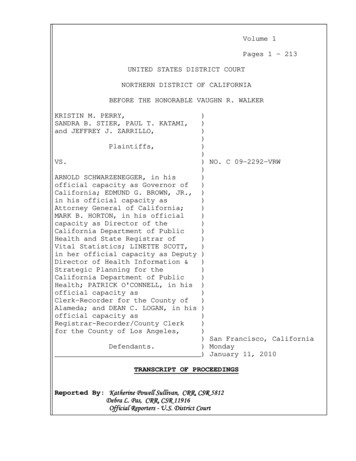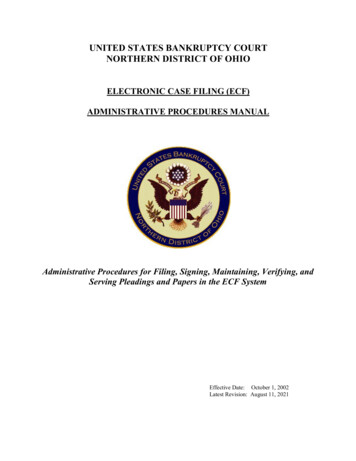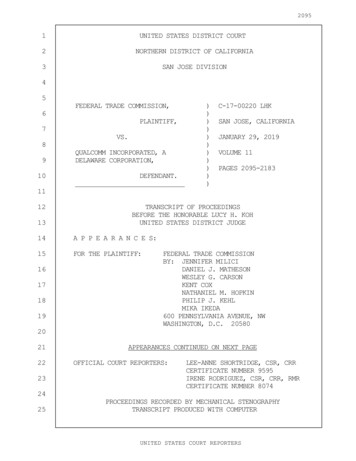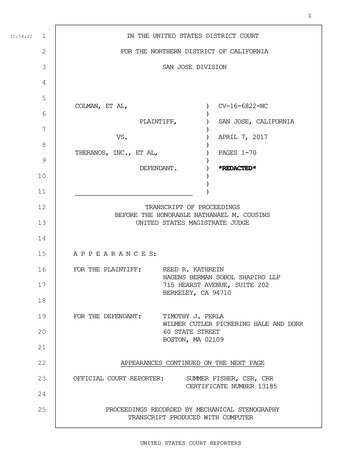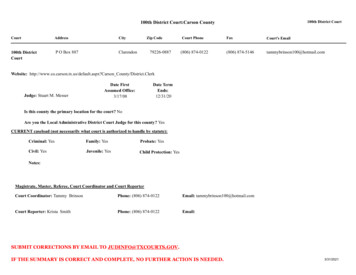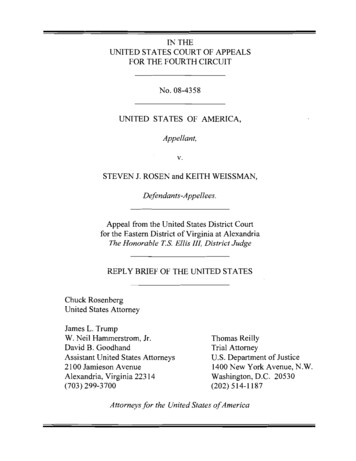
Transcription
Case 4:19-cv-01774 Document 1 Filed on 05/15/19 in TXSD Page 1 of 29UNITED STATES DISTRICT COURTFOR THE SOUTHERN DISTRICT OF TEXASHOUSTON DIVISION)SECURITIES & EXCHANGE COMMISSION, ))Plaintiff,)Civil Action No.: 4:19-cv-1774)v.))ANDREW I. FARMER,)EDDIE D. AUSTIN, JR.,)SCOTT R. SIECK,)CAROLYN P. AUSTIN)and)JOHN D. BROTHERTON,))Defendants.))COMPLAINTPlaintiff United States Securities and Exchange Commission (the “Commission”) alleges:NATURE OF THE ACTION1.Between at least May 2011 and May 2017, Defendants, acting as a Group(hereinafter the “Group”) planned and perpetrated a securities fraud scheme involving thesuccessive, serial “pump-and-dump” of multiple different penny stocks quoted on U.S. markets.The Group’s leadership included Defendants Farmer, Eddie Austin, Sieck, and, at various times,Brotherton, with Defendant Carolyn Austin also aware of the Group’s activities and sharing in itsillicit proceeds. The Group coordinated its illegal pump-and-dump scheme through frequentmeetings in, among other locations, a windowless conference room in Houston (to which itreferred as its “war room”), as well as through encrypted communications. Between April 2014and May 2017 alone, the Group’s scheme included at least five different penny stock issuers(hereinafter the “Issuers”) and yielded at least 15 million in ill-gotten gains.
Case 4:19-cv-01774 Document 1 Filed on 05/15/19 in TXSD Page 2 of 292.A “pump-and-dump” is a species of securities fraud involving “penny stocks,”which are stocks publicly quoted on U.S. over-the-counter markets and having share pricesranging from just pennies to as much as five dollars. A “pump-and-dump” typically involves atleast four major integrated, fraudulent phases, often referred to as “get the stock,” “prime thepump,” “pump the stock,” and “dump the stock.” In the first stage, the perpetrators secretlyacquire all, or virtually all, of a penny stock issuer’s freely tradeable stock, typically allocatingthe stock’s nominal ownership across an array of alter ego front companies. Next, theyorchestrate coordinated trading to create the false appearance of market interest in the stock andto set artificially elevated share prices. Next, they orchestrate materially misleading promotionalcampaigns urging investors to buy the stock based on purported prospects of imminent gains.Finally, they exploit the share price and trading volume rises their actions have created byunloading their stock on unsuspecting investors, who are typically left holding worthless paperafter their promotional campaigns end. A pump-and-dump typically involves violations of boththe antifraud and the securities registration provisions of the federal securities laws.3.To implement its own pump-and-dump scheme, the Group followed this generalpattern, but added additional features designed both to enhance its scheme’s profitability and tofrustrate its detection. In its scheme’s “get the stock” phase, the Group first obtained secretcontrol over all, or virtually all, of each of the Issuers’ outstanding stock, and installed afigurehead CEO, whose actions it could direct, at each Issuer. The Group then proceededfraudulently to obtain, and to deposit with its various foreign and domestic alter ego entities,purportedly free-trading shares of each Issuer’s stock.2
Case 4:19-cv-01774 Document 1 Filed on 05/15/19 in TXSD Page 3 of 294.The Group next “primed the pump” by orchestrating “matched” or otherwisecoordinated trades (in which both buyer and seller were secretly in league, working together tocreate the illusion of market demand and to set artificially elevated prices) in each Issuer’s stock.5.In order to then “pump the stock” the Group secretly arranged for and fundedmassive, materially misleading promotional campaigns. These campaigns primarily featuredemail blasts and online “click ads,” and the Group timed these campaigns to coincide with pressreleases it caused each Issuer to disseminate. In preparation for this phase of its scheme, theGroup had met and formulated materially misleading “story arcs” for each Issuer. Each “storyarc” set forth the Issuer’s supposed line of business and a detailed timeline for when the Issuerwould disseminate press releases and what those releases would say. The goal of each “storyarc” was to induce investors to purchase the Issuer’s stock. When carrying out its promotionalcampaigns for each Issuer, the Group followed these “story arcs.”6.After the Group’s coordinated and matched trading (priming) and promotionalcampaigns (pumping) caused the price of each stock to rise, the Group dumped its stock into themarket. It then distributed the ill-gotten gains among the Group’s leaders using complex andsecretive means designed to avoid detection.7.From Spring 2014 to Spring 2017, the Issuers whose stocks were the subject ofthe Group’s pump-and-dump schemes included:a. Puget Technologies, Inc., whose ticker symbol was PUGE (hereinafter“Puget”);b. Gankit Corporation, whose ticker symbol was GANK (hereinafter “Gankit”);c. Nhale, Inc., whose ticker symbol was NHLE (hereinafter “Nhale”);3
Case 4:19-cv-01774 Document 1 Filed on 05/15/19 in TXSD Page 4 of 29d. Horizon Energy Corp., whose ticker symbol was HORI (hereinafter“Horizon”); ande. Valmie Resources, Inc., whose ticker symbol was VMRI (hereinafter“Valmie”).8.By the conduct described herein, Farmer, Eddie Austin, Sieck, Carolyn Austin,and Brotherton violated the antifraud provisions of the Securities Act of 1933 (“Securities Act”)[15 U.S.C. § 77q(a)], and the Securities Exchange Act of 1934 (“Exchange Act”) [15 U.S.C. §§78j(b)] and Exchange Act Rule 10b-5 [17 C.F.R. §§ 240.10b-5], as well as the registrationprovisions of the Securities Act [15 U.S.C. §§ 77e(a) and (c)]. Defendants will continue toviolate the aforementioned provisions unless restrained or enjoined by this Court. Accordingly,the Commission seeks injunctive relief, disgorgement of ill-gotten gains, prejudgment interest,civil penalties, and other appropriate and necessary equitable and ancillary relief.JURISDICTION AND VENUE9.This Court has jurisdiction over this action pursuant to Securities Act Sections20(d)(1) and 22(a) [15 U.S.C. §§ 77t(d)(1) and 77v(a)] and Exchange Act Sections 21(d), 21(e),21A, and 27 [15 U.S.C. §§ 78u(d), 78u(e), 78u-1, and 78aa].10.Defendants, directly or indirectly, made use of the means and instrumentalities ofinterstate commerce, of the mails or of the facilities of a national securities exchange, inconnection with the acts, practices, and courses of business alleged herein, certain of whichoccurred within the Southern District of Texas.11.Venue in this district is proper under Section 22(a) of the Securities Act[15 U.S.C. § 77v(a)] and Section 27 of the Exchange Act [15 U.S.C. § 78aa] because certain of4
Case 4:19-cv-01774 Document 1 Filed on 05/15/19 in TXSD Page 5 of 29the acts, practices, transactions, and courses of business constituting the violations alleged hereinoccurred within the Southern District of Texas.DEFENDANTS12.Andrew Ian Farmer (“Farmer”), age 40, is a U.S. citizen residing in Houston,Texas. As detailed below, Farmer helped oversee and coordinate virtually every aspect of thepump-and-dump scheme detailed herein. On February 1, 2019, Farmer pleaded guilty to onecount of conspiracy to commit wire fraud and securities fraud in violation of 18 U.S.C. § 371 andone count of securities fraud in violation of 15 U.S.C. §§ 77q(a) and 77x, before this court inUnited States v. Farmer, et al., Crim. No. 4:16-CR-408 (S.D. Tex.).13.Eddie Douglas Austin, Jr. (“Eddie Austin”), age 68, is a U.S. citizen currentlyresiding in Houston, Texas. Eddie Austin is married to Defendant Carolyn Austin. Eddie Austinis a former stockbroker (who was sanctioned by the New York Stock Exchange in 1986) and aformer lawyer (who was permanently barred, by consent, from practicing law “in Louisiana orany other jurisdiction” in 2011 (see In re Austin, 60 So.3d 604 (La. 2011)), and from appearingor practicing before the Commission in 2013 (see Matter of Eddie Douglas Austin Jr., Esq.,Exchange Act Rel. No. 34-69326/April 5, 2013). In January 2013, he consented to a permanentantifraud injunction and penny stock bar in settlement of an SEC penny stock fraud case. SeeSEC v. Sunrise Solar Corporation et al., Civil Action No. 5:12-CV-918 (W.D. Tex., filed Sept.28, 2012). His role in the scheme included participating in “war room” strategy meetings,helping formulate “story arcs” for the various Issuers, and funding various expenditures he knewto be in furtherance of pump-and-dumps of the various Issuers’ stock. On January 16, 2019,Eddie Austin pleaded guilty in United States v. Farmer, et al., Crim. No. 4:16-CR-408 (S.D.Tex.) to one count of conspiracy to commit wire in violation of 18 U.S.C. § 371.5
Case 4:19-cv-01774 Document 1 Filed on 05/15/19 in TXSD Page 6 of 2914.Scott Russell Sieck (“Sieck”), age 60, is a U.S. citizen residing in Winter Park,Florida. Sieck is a former stockbroker who was permanently enjoined, by consent, in settlementof an SEC penny stock fraud enforcement action, from violating the antifraud and registrationprovisions of the federal securities laws. See SEC v. Scott R. Sieck et al., Civil Action No. 996165-CIV-Dimitroulas (S.D. Fla., filed Feb. 10, 1999). In this pump-and-dump scheme, Sieckoversaw the Group’s trading in the various Issuers’ stock and, in doing so, among other thingsrecruited and directed brokers to effect trades in the Issuers’ stock for the Group’s benefit. Sieckalso attended the Group’s “war room” strategy meetings during which the “story arcs” for thevarious Issuers were formulated. On January 14, 2019, Sieck pleaded guilty in United States v.Farmer, et al., Crim. No. 4:16-CR-408 (S.D. Tex.) to one count of conspiracy to commit wirefraud in violation of 18 U.S.C. § 371.15.Carolyn Price Austin (“Carolyn Austin”), age 64, is a U.S. citizen currentlyresiding in Houston, Texas. She is married to Defendant Eddie Austin. She has twice beenpermanently enjoined, by consent, in settlement of separate SEC penny stock fraud enforcementactions, the first enjoining future violations of the securities registration provisions, and thesecond adding a penny stock bar. See SEC v. Sunrise Solar Corporation et al., Civil Action No.5:12-CV-918 (W.D. Tex., filed Sept. 28, 2012) and SEC v. Farmer et al., Civil Action No. 4:14cv-02345 (S.D. Tex., filed Aug. 14, 2014). Her role in the scheme included attending theGroup’s “war room” strategy meetings at which the Group formulated promotional strategiesconcerning the various Issuers, and allowing the Group to open and to use, in furtherance of thescheme, accounts bearing her name. On January 16, 2019, Carolyn Austin pleaded guilty inUnited States v. Farmer, et al., Crim. No. 4:16-CR-408 (S.D. Tex.) to one count of misprision ofa felony in violation of 18 U.S.C. § 4.6
Case 4:19-cv-01774 Document 1 Filed on 05/15/19 in TXSD Page 7 of 2916.John David Brotherton (“Brotherton”), age 59, is a U.S. citizen currentlyresiding in a federal detention facility in Conroe, Texas, where he is awaiting sentencing inUnited States v. Farmer, et al., Crim. No. 4:16-CR-408 (S.D. Tex.). Brotherton participated in“war room” strategy meetings―during which he and others formulated the “story arcs” for thevarious Issuers―and coordinated promotions for the Group’s pump-and-dumps through late2013. Brotherton later rejoined the Group’s scheme during its Valmie pump-and-dump, inwhich he assisted in formulating promotional strategies and received distributions of illicit stocksale proceeds. On February 12, 2019, Brotherton pleaded guilty in United States v. Farmer, etal., Crim. No. 4:16-CR-408 (S.D. Tex.) to one count of conspiracy to commit wire fraud inviolation of 18 U.S.C. § 371.THE ISSUERS17.Puget Technologies, Inc. (“Puget”) is a Nevada corporation headquartered,during the relevant period, first in Fort Lauderdale, Florida, and then in Englewood, Colorado.Puget was in the business of developing “innovative cannabinoid products and therapies” for thetreatment of various diseases. At all relevant times, Puget’s securities were quoted on OTC Linkunder the symbol “PUGE.” Puget filed periodic reports, including Forms 10-K and 10-Q, withthe Commission until September 23, 2015. From June 2013 through May 2014, the Group (i)made an unregistered offering of 14.95 million shares of Puget’s stock, comprising over 99.6%of the Company’s unlegended shares, (ii) conducted a massive, materially misleadingpromotional campaign touting Puget, and (iii) dumped its artificially inflated shares of Pugetstock into an unsuspecting market. By so doing, the Group reaped, from its securitiesregistration and securities fraud violations, at least 1.33 million in illicit Puget trading profits inMay 2014 alone.7
Case 4:19-cv-01774 Document 1 Filed on 05/15/19 in TXSD Page 8 of 2918.Gankit Corporation (“Gankit”) was a Nevada corporation headquartered inHouston, Texas that purportedly operated an online auction website. At all relevant times,Gankit’s securities were quoted on the OTC Link under the ticker symbol “GANK.” Gankitfiled periodic reports, including Forms 10-K and 10-Q, with the Commission until April 11,2014. (On June 13, 2014, Gankit’s name and ticker symbol were changed to Nhale, Inc. andNHLE, described below.) From August 2013 through June 12, 2014, the Group (i) made anunregistered offering of as many as 5.8 million shares of Gankit’s stock, comprising as much as58% of the Company’s unlegended shares, (ii) conducted a massive, materially misleadingpromotional campaign touting Gankit, and (iii) dumped its artificially inflated shares of Gankitstock into an unsuspecting market. By so doing, the Group reaped, from its securitiesregistration and securities fraud violations, at least 100,650 in illicit Gankit trading profitsbetween May and mid-June 2014 alone.19.Nhale, Inc. (“Nhale”), the successor to Gankit (see above), was a Nevadacorporation headquartered in Houston, Texas that purportedly engaged in the distribution of nonflame smoking devices and in the pursuit of marijuana legalization. At all relevant times,Nhale’s securities were quoted on the OTC Link under the ticker symbol “NHLE.” Nhale filedperiodic reports, including Forms 10-K and 10-Q, with the Commission until January 13, 2017.From June 13, 2014 through at least January 7, 2015, the Group (i) made an unregisteredoffering of as many as 4.2 million shares of Nhale’s stock, comprising as much as 42% of theCompany’s unlegended shares, (ii) conducted a massive, materially misleading promotionalcampaign touting Nhale, and (iii) dumped its artificially inflated shares of Nhale stock into anunsuspecting market. By so doing, the Group reaped, from its securities registration and8
Case 4:19-cv-01774 Document 1 Filed on 05/15/19 in TXSD Page 9 of 29securities fraud violations, at least 1.1 million in illicit Nhale trading profits between June 2014and January 2015 alone.20.Horizon Energy Corp. (“Horizon”) was a Wyoming corporation headquarteredin Gulfport, Mississippi that purported to produce solar energy products and solutions. At allrelevant times, Horizon’s securities were quoted on the OTC Link under the ticker symbol“HORI.” Horizon filed periodic reports, including Forms 10-K and 10-Q, with the Commissionuntil November 12, 2014. From June 19, 2013 through at least October 20, 2014, the Group(i) made an unregistered offering of as many as 5.229 million shares of Horizon’s stock,comprising as much as 52.9% of the Company’s unlegended shares, (ii) conducted a massive,materially misleading promotional campaign touting Horizon, and (iii) dumped its artificiallyinflated shares of Horizon stock into an unsuspecting market. By so doing, the Group reaped,from its securities registration and securities fraud violations, at least 1.436 million in illicitHorizon trading profits between May and October 2014 alone.21.Valmie Resources, Inc. (“Valmie”) is a Nevada corporation with its principalplace of business in Houston, Texas. Originally incorporated in 2011, and quoted on OTC Linksince December 2012, Valmie underwent several changes to its business plan beforecharacterizing itself, beginning in January 2015, as a provider of unmanned aerial vehicleservices, or “drones.” At all relevant times, Valmie’s securities were quoted on the OTC Linkunder the ticker symbol “VMRI.” Valmie filed periodic reports, including Forms 10-K and 10Q, with the Commission until April 13, 2017. The Commission suspended trading in VMRI onMay 4, 2017. From May 2014 through May 3, 2017, the Group utilized fraudulent devices thatincluded filing false registration statements, coordinating trading, and secretly fundingpromotional campaigns to reap at least 7.67 million in illicit Valmie trading profits.9
Case 4:19-cv-01774 Document 1 Filed on 05/15/19 in TXSD Page 10 of 29OTHER RELEVANT PERSONS AND ENTITIES22.Black Diamond Media, Inc. (“Black Diamond”) was, at all relevant times aTexas corporation (incorporated in September 2016) with its principal place of business inHouston, Texas. The Group used Black Diamond to arrange for and fund promotions of Valmieand receive distributions of Valmie stock sale proceeds.23.Meridian Investment Group Inc. (“Meridian”) was, at all relevant times, aWyoming corporation with its principal place of business in Oviedo, FL, and owned by Sieck.The Group used Meridian as a platform to effect matched and coordinated trading in, as well assales of, the various stocks comprising the scheme in furtherance of each pump-and-dump’sprime the pump and dump the stock phases.24.Spot Marketing LLC (“Spot Marketing”) was, at all relevant times, a Wyomingcorporation (incorporated in March 2012) with its principal place of business in Houston, Texas.The Group used Spot Marketing to arrange and fund promotions of the scheme’s various stocksand to receive distributions of their trading proceeds.FACTSDefendants’ Years-Long Pump-and-Dump Scheme25.In 2011, Defendants Farmer, Eddie Austin, Sieck, and Brotherton formed theirGroup (the “Group”), which they dedicated to perpetrating serial, successive pump-and-dumpfrauds with U.S. penny stocks, with Carolyn Austin to share, with Eddie Austin, in the Group’sprofits.26.Throughout the next six years, Farmer, Sieck, and Eddie Austin were Partners inthe Group, in that, on an informal and unaudited basis overseen by Farmer, each receivedapproximately equivalent distributions of each pump-and-dump’s net proceeds (except that10
Case 4:19-cv-01774 Document 1 Filed on 05/15/19 in TXSD Page 11 of 29Eddie and Carolyn Austin together constituted a single Partner share). Brotherton was a Partnerin all of the Group’s pump-and-dumps occurring during his Group participation, which wascontinuous until in or around late 2013, and that resumed by 2015, during the Group’s Valmiepump-and-dump. For purposes of various of its pump-and-dumps within the past five years, andtypically with Eddie Austin’s concurrence, Farmer also caused the Group to add an additionalPartner or Partners.27.Between at least its formation in or about May 2011 and May 2017, the Groupcommitted pump-and-dump frauds with penny stocks quoted for trading on U.S. markets. Ofthese pump-and-dumps, the five involving the Issuers occurred, in whole or in part, within themost recent five years.28.In perpetrating the scheme, the Group carried out essentially the same steps witheach Issuer’s stock. Each pump-and-dump fraud began with the Group acquiring control of ashell company either having, or that it soon outfitted with, what the Group considered to be anappealing-to-penny-stock-investors business plan, and over which it installed, as CEO, either aGroup employee or a figurehead it recruited, whose activities the Group could, and did, direct.Each also involved a company with little to no genuine business or revenue that the Groupnonetheless would aggressively promote as supposedly offering extremely lucrative prospects forbuyers of its stock. Each involved massive and profitable dumping of the stock by the Group,through its foreign and domestic front companies, into the price and volume rises its promotionalcampaigns triggered. This dumping, in each case, also violated the registration provisions. Andin each, the investors the Group deceived were left holding virtually worthless paper after theGroup’s promotions ceased.11
Case 4:19-cv-01774 Document 1 Filed on 05/15/19 in TXSD Page 12 of 29I. Phase One: Getting the Stock (in both “unrestricted” and market-tradeable form)A. Making A Sham Public Offering (Gankit/Nhale and Horizon)29.In the case of three of the Issuers (Gankit, which became Nhale, and Horizon,which had started as Solar America), the Group effected a sham public offering, for the purposeof delivering purportedly free-trading stock to its alter ego front companies while, in fact,evading the securities registration provisions of the federal securities laws. In orchestrating thesesham offerings, the Group acted principally through Farmer and, in the case of SolarAmerica/Horizon, through Eddie Austin as well. For these Issuers, the sham offerings were thesubject of S-1 registration statements filed with the Commission.30.Although Solar America’s S-1 was filed on June 7, 2011 and became effective onMarch 29, 2012, the Group’s distribution of Horizon shares in reliance on that S-1 continued intoOctober 2014.31.Although Gankit’s S-1 was filed on July 29, 2012 and became effective onNovember 28, 2012, the Group’s distribution of Gankit and Nhale shares in reliance on that S-1continued into January 2015.32.Both Solar America’s S-1 and Gankit’s S-1 purported to register a “self-underwritten, best-efforts” offering through which each company’s CEO, without assistancefrom agents or other third parties, would attempt to sell the offered shares to bona fide,unaffiliated purchasers. Each of these claims, however, was materially false and misleadingbecause the offerings that actually occurred were drastically different from those described in theregistration statements.33.In fact, the Group rigged both offerings in a manner designed to give the Groupcontrol of millions of shares of purportedly unrestricted stock while creating the false appearance12
Case 4:19-cv-01774 Document 1 Filed on 05/15/19 in TXSD Page 13 of 29that bona fide purchasers, and not the Group, were the shares’ buyers. The Group did this bylining up straw purchasers, with the understanding that each would be afforded an opportunity insix months’ time to remit the stock back to Farmer, or other Group personnel, for a 50% profit,and with the expectation (nearly always justified) that each straw purchaser would do so.Although each purchaser signed a subscription agreement and paid by check or wire, ostensiblyevidencing a bona fide purchase, these transactions were not legitimate because of, among otherthings, the expectation that these purchasers would later sell their shares back to the Group.34.During the Solar America offering, for example, Eddie Austin emailed a relativeon April 10, 2012, saying, in part: “Hi . Another chance for you to make a 50% return withinsix months. 10,000 investment. Talk tomorrow. Love ya.” This email included a forwardedmessage from Farmer saying in part, “Eddie, here is the subscription agreement for [yourrelative] to sign,” and attaching a Solar America subscription agreement. The relative promptlysigned and returned the agreement, along with a 10,000 check (to subscribe for 500,000 SolarAmerica shares), to Farmer’s office. Within four months, by August 15, 2012 (following a 3for-1 stock split), certificates for 1.5 million Solar America shares had been issued in therelative’s name. On October 31, 2012, Farmer bought back these shares from the relative at the50% return Eddie Austin had promised, using a 15,000 check drawn on one of the Group’sdomestic alter ego companies’ account.35.Like Eddie Austin’s relative, the vast majority of the purported purchasers ofSolar America’s offering likewise soon resold their shares to a Group alter ego entity. In makingthese “sales,” each did so at the very same share price, and on or about the same dates, as oneanother. As a result of these transactions, virtually all the Solar America offering’s shares weresoon reconsolidated into share certificates issued in the names of the Group’s foreign and13
Case 4:19-cv-01774 Document 1 Filed on 05/15/19 in TXSD Page 14 of 29domestic alter ego entities, which, in the case of that offering, totaled nine in number. As notedabove, the Group’s public sales of the shares that were reconsolidated continued into October2014, by which time Solar America had become Horizon.36.Similarly, in the case of Gankit/Nhale, the Group lined up thirty-seven strawpurchasers to purportedly fully subscribe to every last share in the Gankit offering. By prearrangement, every single share so purchased was likewise reconsolidated into share certificatesissued in the names of the Group’s foreign and domestic alter ego entities, which, in the case ofthat offering, totaled six in number. As noted above, the Group’s public sales of the shares thatwere reconsolidated continued into January 2015, by which time Gankit had become Nhale.37.The above-described conduct gave the false impression of bona fide publicofferings for both Solar America/Horizon and Gankit/Nhale, which, if genuine, would havemade each’s securities freely tradeable on the secondary market. In reality, however, becausethe offerings were shams, Solar America/Horizon and Gankit/Nhale’s stock remained restricted,and the Group’s subsequent sales of that stock, which continued until October 2014 and January2015, respectively, constituted unregistered offerings of securities in violation of the registrationprovisions of the federal securities laws.B. Filing Fraudulent Market-Quotation Applications (Gankit/Nhale and Horizon)38.Also in the case of Gankit/Nhale and Horizon (which started as Solar America),the Group, acting principally through Farmer, orchestrated a materially false and misleadingapplication to FINRA to have each company’s shares quoted on the Over-the-Counter (“OTC”)market (and thus readily tradeable by retail investors through their brokerage accounts).39.In particular, the Group arranged for these Issuers to engage a market maker tofile a Form 211 with FINRA applying to have each Issuer’s stock cleared for quotation on the14
Case 4:19-cv-01774 Document 1 Filed on 05/15/19 in TXSD Page 15 of 29OTC. A Form 211 calls for disclosure of certain detailed information about the issuer, whichFINRA uses, along with any supplemental information supplied in response to its follow-upquestions, to determine whether the issuer meets the relevant regulatory requirements. Withrespect to Gankit/Nhale and Solar America/Horizon, the Group was able to obtain this clearanceonly by misleading FINRA into believing there was sufficient investor interest in eachcompany’s business to warrant its clearing each company’s stock for such quotation.40.As additional groundwork for this second step, the Group, principally throughtaking steps devised during its “war room” strategy meetings, ensured that both companiessustained a nominal level of operations and filed audited financial statements and periodicreports. This, together with the purported demonstrated interest and participation of individualinvestors in each company’s registered offerings (34 such investors in Solar America’s and 37 inGankit’s) created a façade lending to each the appearance of a legitimate startup company.41.Despite the fact that the Solar America/Horizon and Gankit/Nhale 211Applications were, before being submitted by their market maker sponsor, reviewed and signedby each company’s CEO, it was in fact the Group, acting primarily through Farmer, that eitherdirected the 211 Application’s preparation, or helped prepare or review it. The same was true ofboth Issuers’ responses to FINRA’s follow-up questions during FINRA’s review of theapplications.42.In both cases, either the original application, or the responses to FINRA’s follow-up questions, or both, included materially false and misleading representations. SolarAmerica/Horizon’s 211 file, for example, included a false claim that “no past, present or futurearrangement exists by which any person or entity would control the sale, transfer, disposition or any other aspect of the shares listed on the shareholder list other than the person or entity15
Case 4:19-cv-01774 Document 1 Filed on 05/15/19 in TXSD Page 16 of 29identified as the shareholder.” As Farmer and his Partners in the Group well knew, however, theGroup in fact had arrangements in place with every person on the shareholder list that it expectedwould result (and in virtually every case did result) in those persons’ shares being reconsolidatedinto the hands of the Group. For its part, Gankit/Nhale’s 211 File includes the false andmaterially misleading claims that, among other things, the thirty-seven individuals whopurportedly purchased all the shares in Gankit’s public offering had been drawn to the companythrough one of their number’s happening to come across the Company’s website, and thenrecruiting the others.C. Obtaining “Free Trading” Shares (All Issuers)a. Solar America/Horizon and Gankit/Nhale43.Because of the false appearance that Solar America’s/Horizon’s andGankit’s/Nhale’s stock had been issued in bona fide public offerings, and because the Groupconcealed from the transfer agents (i) its direct role in the aforementioned public offerings and(ii) its common ownership of all the foreign and domestic entities requesting cancellation andreissuance of shares in these Issuers’ stock, each transfer agent mistakenly concluded that eachIssuer’s stock could be issued without restrictive legend.44.Shares issued without restrictive legend are immediately and freely tradeable. Butshares obtained through
Eddie Douglas Austin, Jr. ("Eddie Austin"), age 68, is a U.S. citizen currently residing in Houston, Texas. Eddie Austin is married to Defendant Carolyn Austin. Eddie Austin is a former stockbroker (who was sanctioned by the New York Stock Exchange in 1986) and a

